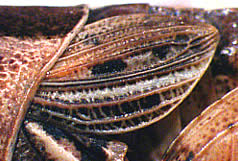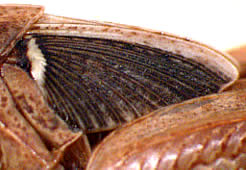As in all insects, the development of juvenile locusts occurs in discrete stages called instars. Juvenile locusts are called nymphs or hoppers. Locusts exhibit what is termed partial metamorphosis, where the juvenile stages resemble the adults (see Lifecycle of a locust). Insects such as butterflies, moths, bees, wasps, ants and flies exhibit complete metamorphosis, where the juvenile stages (larvae) bear no resemblance to the adults.
In grasshopper and locust nymphs, the developing wings are referred to as wingbuds and are visible on the second and third segments of the thorax - called the mesothorax (middle) and metathorax, respectively. These segments are behind the pronotum. The transformation of the wingbuds into functional wings for flight is only complete when a hopper reaches adulthood. The forewings arise from the mesothorax and the hind wings (the flying wings) arise from the metathorax.
In some species of grasshoppers the adults possess wings that resemble the wingbuds of hoppers, and are generally incapable of flight. Two such species of grasshopper include the Stripe-winged meadow grasshopper and the Wingless grasshopper: Phaulacridium vittatum. In some cases this can create difficulties in the identification of species and of life stage.
The pattern of veins on the wing bud can be used to distinguish adults of wingless species from nymphs of fully winged locust species. The pattern of wing venation of wingless (or brachypterous) grasshoppers is either parallel or net-like as shown below.

Wing of an adult brachypterous grasshopper
Brachyexarna lobipennis. wing 4-5 mm in length
The pattern of wingbud venation in nymphs of fully winged (or macropterous) locusts and grasshoppers is roughly fan-shaped with the veins radiating out from along the top and base of the wingbud as shown below.

Wingbud of a fifth-instar Australian plague locust
Chortoicetes terminifera nymph. wing 4-5 mm in length
